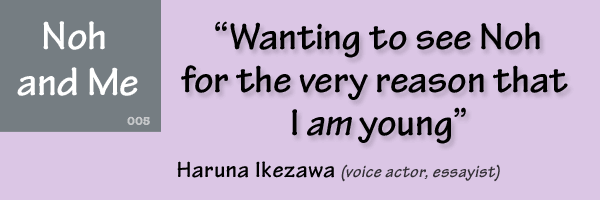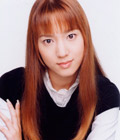 |
 |
 |
| | Home | Essay : Noh and Me | Haruna Ikezawa |
| |
|
|
There are those who were involved with Noh from a very young age.
There are those who were attracted to Noh as adults. There are all sorts of relations with Noh.
We will be speaking with a variety of people from various walks of life about their experiences
with and relation to Noh, its attraction for them and its charms.

 |
Illustration: Takeuma |
It began with an email from my father. “Do you want to go see Noh?”
If I think back, the first time I saw Noh and Kyōgen was as an elementary-school pupil when we went to see it as part of a Social Studies class. It was also the last time I’d seen it.
Kabuki and Bunraku, on the other hand, I’d been to see many times.
I’d go to see Kabuki with a friend who liked it and would took me along.
And Bunraku I’d gone to see with my father back in grade school. We’d take a lunch and watch the whole thing straight through.
Both of them were interesting and the memories and pictures of those times are still strong in my mind.
But, I have no memory of Noh. Perhaps, Noh was, for me as a grade-school pupil, just a bit too stoic.
Things would unfold on this mysterious stage. Mysterious people would talk of mysterious tales. In my young mind the only thing I took away from it was thinking, “This kind of world exists as well, but I don’t understand it very much.”
After that I never went to see Noh or Kyōgen of my own accord.
I think that’s the case with the majority of Japanese of my generation.

This time around I was asked if I wouldn’t write something about Noh and my first response was to think hesitantly, “Am I the right person for that?”
But, I thought a little bit and started to feel, well, maybe I should just write for that very reason, because it is me.
Maybe for other people like me, people who didn’t go to see Noh, those who had an interest but would never just go on their own to see it, maybe this would be the thing that would finally get them to go see a play. And, if they did, I thought, I’d be happy.
The pieces I was invited to see were the Kyōgen play “Busu(The Delicious Poison)”, and the Noh play “Kagekiyo.” *
“Busu” was what I’d seen when I was in grade school and for me, who had never gone to see anything after that, it kind of felt fated to be going to see it again.
Since I was going to go to the Noh Theater I’d done a bit of homework on “Kagekiyo” and knew generally what it was about. I’d looked it up on the Internet and found everything from the actual lines to the modern-day translation, its history and its highlights.
First of all, “Busu.”
Ah, now here was a straight-forward fun piece, one that made me laugh out loud.
I didn’t even need the explanatory subtitles that came up on the monitor in front me. I could understand things well enough without them.
The actors I saw complemented each other perfectly, the big, lumbering Tarō Kaja and the small, thin, and quick Jirō Kaja.
It was a good piece, one with peculiar, yet wonderfully timed jokes, comical hand and body movements, natural, easy dialogue and in-no-way-affected laughter.
And moreover, Tarō and Jirō wore these fabulous lemon-colored tabi socks. They were added the right touch and left quite an impression on me.
*"Busu, Kagekiyo" at the National Noh Theatre, Tokyo, Sep 1 2010

Then came the break and “Kagekiyo.”
The piece I’d researched started and in that very moment, a shiver and chill ran through my body and I thought, “This is a far cut above the Kyōgen.”
It started quietly.
There was no ringing of bells.
There was no rising of curtains.
The start was silent and stole across the stage like a ripple of water.
Then, the cutting sound of a flute and to that came the hard sound of the big drum, the softer tone of the small drum and the richness of the chorus.
It drew me in faster and faster as I continued to watch.
Aku Shichibyōe Kagekiyo, now a ruined old man, his eyesight gone, a man who had once been a nobleman who now could no longer even take care of himself.
His own daughter comes to visit him and he, not wanting her to see him in his degraded state, says, to preserve his own dignity, “I don’t know the man you speak of.”
His anger flares when the villager says, “You are Kagekiyo and I have brought your daughter.” But then he quickly apologizes, calling himself a man who “lives only by the pity of others, a man helpless if he loses someone who will help him.” He drops his head stiffly.
Misunderstandings. A father who misreads his daughter, a daughter who misreads her father.
The sad state of an old man who prepares to take leave of this world.
His hand in his daughter’s back as he pushes her away, pushes her along the stage runway.
Each movement of the actors, each word spoken from the depths of the soul. Reaching down and wrenching at my heart, I realized that I was crying.

It was a very simple work.
One could say even “austere.”
And for that very reason, with everything pared away, all gone, what stood out was the very essence of the human.
On stage wasn’t just some stylized reality. It was real.
I thought, I was really glad to have seen Noh.
If I hadn’t seen it now, I probably would never have seen it again.
If you see it now, you’ll realize later, after many years, and when you come to understand the inner workings and subtleties of the human heart, what a first-rate pleasure you have gained.
It’s almost like brewing some rice wine and setting it aside for later.
Or maybe like planting a sapling that will grow into a tree and bear fruit.
Even just once a year, or once every two years, or even once every five years, it doesn’t matter.
Going to see Noh is not something special, it can be seen simply as a habit of life.
There will surely come a time, a moment, when you will want to return to the serenity of Noh.
(October 2010)
 |
Haruna Ikezawa Born in Athens, Greece. Debuted as an anime voice actor in 1995 with the anime film “Aitenshi Densetsu Wedding Peach.” Currently works as actor and voice actor. Writes “Haruna Ikezawa’s Tensei Himego” for Mac Fan magazine and others. Serialized works include “Otome no Dokushodo (The Young Girl’s Path of Reading)” for Hon no Zasshi (Book Magazine), as well as “The ‘S’ in SF is ‘S’ as in Splendid” in S-F Magazine. Her father is the writer Natsuki Ikezawa. |
| Terms of Use | Contact Us | Link to us |
Copyright©
2026
the-NOH.com All right reserved.